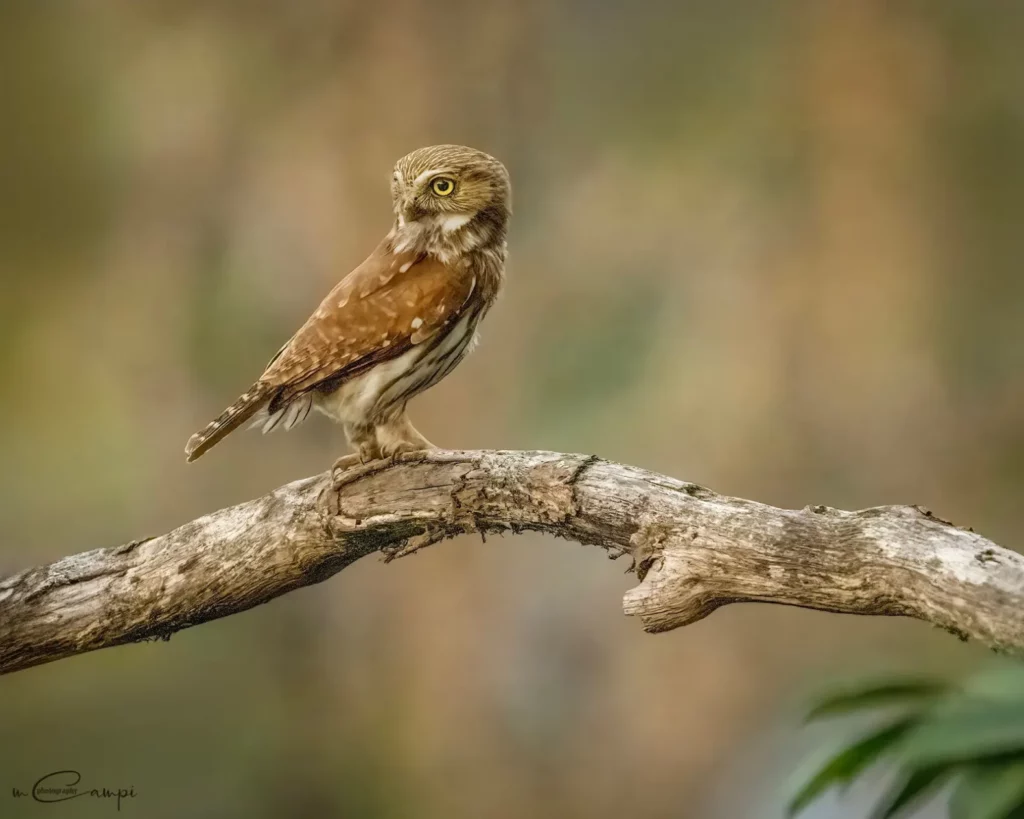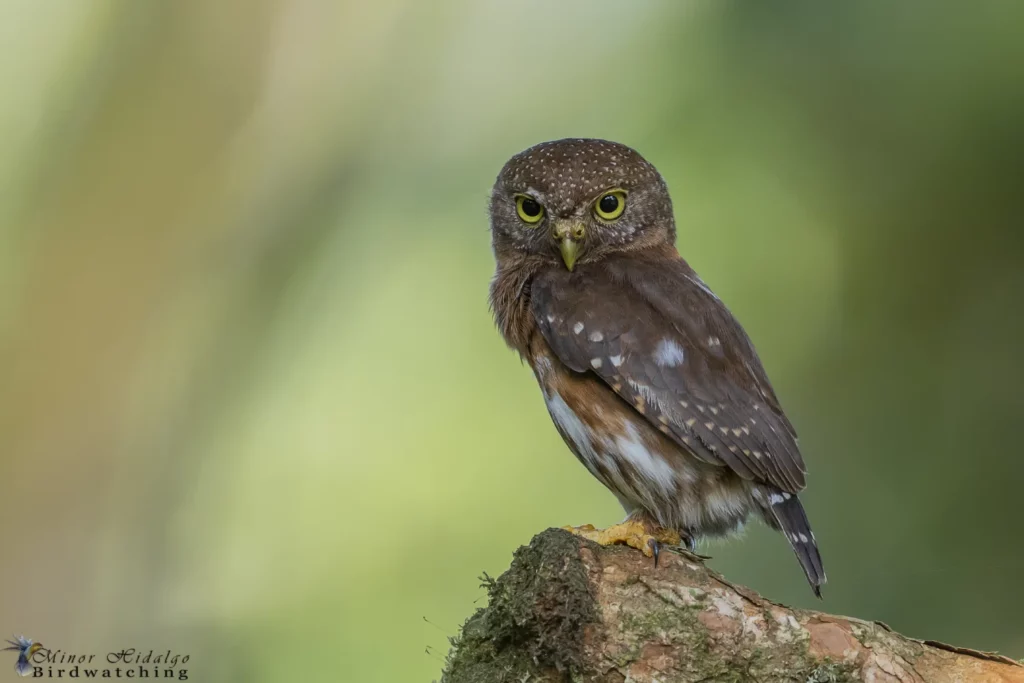Ferruginous Pygmy Owl
The Ferruginous Pygmy Owl is one of the most remarkable small owls in the Americas. Known for its tiny size and bold nature, this owl is commonly found throughout Costa Rica, where it thrives in a variety of habitats. Below is a detailed overview of this species, focusing on both its general characteristics and its…

Glaucidium brasilianum
Scientific Name
Strigidae (Owls)
Family
Strigiformes
Order
G. b. cactorum: Found in northern Mexico, southern Arizona, and Texas.
Subspecies.
G. b. brasilianum: Found across Central and South America.
Subspecies.
Range and Habitat
Geographic Range
The owl’s range spans from southern Arizona and Texas in the United States, down through Mexico, Central America, and into South America, reaching as far south as Argentina. Despite its wide distribution, it is most commonly observed in tropical environments like Costa Rica.
Migratory Patterns
The species is generally non-migratory, though some local shifts in territory occur based on food availability.
Preferred Habitat
Ferruginous Pygmy Owl prefers areas with dry forests, riverine woodlands, and forest edges, and can even adapt to suburban areas with sufficient tree cover.
Altitude Range
Most commonly found in lowland habitats but can be seen at altitudes up to 2,000 meters (6,500 feet)
Costa Rica Habitat
In Costa Rica, the Ferruginous Pygmy Owl is commonly found in lowland forests and semi-open woodlands, thriving in both the Pacific and Caribbean regions. This owl is particularly abundant in the Guanacaste Province, known for its dry forests, and the Caribbean lowlands.
Conservation Status
Least Concern
Conservation Status
Population Status
Globally, the Ferruginous Pygmy Owl is classified as Least Concern by the IUCN, with an estimated population of 20-50 million individuals.
Habitat loss due to agriculture, urbanization, and deforestation. In the United States, populations in Arizona and Texas are endangered due to habitat loss and development.
Conservation efforts
In the U.S., the species is listed as endangered in specific regions, particularly in Arizona. In Costa Rica, ongoing forest conservation helps protect this species.
Primary Threats
Habitat loss due to agriculture, urbanization, and deforestation. In the United States, populations in Arizona and Texas are endangered due to habitat loss and development.
Identification
Ferruginous Pygmy Owl
Rarity Level:
CommonBest Viewing Times:
Early Morning (Dawn - 8 AM)
Size
15–17 cm (5.9–6.7 in) in length, wingspan about 38 cm (15 in).
Plumage
Rusty-brown upperparts with streaked white underparts. Some owls have gray or cinnamon coloring. They feature distinctive “false eyes”—dark spots on the back of their heads that help deter predators
Distinctive Features
Bright yellow eyes, large talons, and a stocky build
Sexual Dimorphism
Females are slightly larger and often more reddish than males
Diet and Feeding Behavior
Primary Diet
- The Ferruginous Pygmy Owl is a skilled hunter, primarily feeding on a variety of prey. Its diet includes: Insects: Grasshoppers, cicadas, crickets, beetles, and moths. Small birds: Often capturing prey twice its size. Reptiles: Lizards and small snakes. Mammals: Small rodents like pygmy mice.
Foraging Techniques
- Hunts by perching and swooping down to seize prey with its talons. This owl is diurnal, meaning it hunts both during the daylight and evening hours, especially at dawn and dusk.
Feeding Times
- Primarily active during the day (diurnal) with peak hunting periods around sunrise and sunset.
Behavior Patterns
Ferruginous Pygmy Owl
Lorem ipsum dolor sit amet, consectetur adipiscing elit, sed do eiusmod tempor incididunt ut labore et dolore magna aliqua.
Social Structure
Typically seen alone or in pairs. Known for its aggressive territorial behavior, defending its territory from larger birds. In Costa Rica, the owl is frequently mobbed by songbirds as a defense mechanism.
Song and Vocalization
Its call is a repetitive, high-pitched whistle (“hoo-hoo-hoo”), commonly used to establish territory or attract a mate.
Birders in Costa Rica often use this call to attract and locate the owl.
Courtship and Mating Ritual
Breeds in late winter to early spring, with simple displays involving mutual vocalizations.
Territoriality
Small songbirds frequently mob this owl to protect their nests.
Birdwatching Tips
Best Locations
In the U.S., birdwatchers can visit southern Arizona’s Altar Valley or Texas's Lower Rio Grande Valley. In Costa Rica, they can be spotted in Guanacaste's dry forests and Caribbean lowland forests.

Best Time of the Year
Year-round in tropical regions like Costa Rica; more commonly spotted in spring in the U.S.
Common Behavior
Listen for the owl’s whistled call and look for small birds mobbing the owl, which often reveals its location.
Recommended Gear
Binoculars, a camera with a good zoom lens, and a bird call app to help identify their distinctive song.
Breeding and Nesting Behavior
Breeding Season
Breeds typically in late winter to early spring, with simple displays involving mutual vocalizations.
Nesting Sites
Nests in tree cavities or holes made by woodpeckers, sometimes in saguaro cacti. In Costa Rica, nests are often found in large, old trees.
Clutch Size
Lays 1-7 white eggs.
Incubation Period
{acf_breeding_and_nesting_incubation_period}
Parental Care
The male delivers food to the female and chicks during the incubation and early fledging period.
Did You Know?
Where can I find Ferruginous Pygmy Owls?
They range from southern Arizona and Texas through Mexico into Central and South America, including Costa Rica, Brazil, and Argentina.
Are Ferruginous Pygmy Owls active during the day?
Yes, unlike most owls, they are diurnal, meaning they are active during daylight.
What do Ferruginous Pygmy Owls eat?
Their diet includes insects, small birds, reptiles, and mammals, such as pygmy mice.
The Ferruginous Pygmy Owl is widespread on the Pacific side of Costa Rica but can also be found in the northern Caribbean Lowlands.
Top locations to spot this owl are the Tarcoles River Estuary, La Ensenada Reserve, Orotina and in backyard and hotel gardens in the Central Valley.
These Owls are presumed to be monogamous. They form pairs during the fall of their first year after hatching. They will nest for the first time the following spring.
Because they are active during daylight hours, they are often mistaken for a passerine.
When this Owl is bothered or agitated it has a unique habit of jerking its tail up and down and side to side.
When surprised the Owl will usually dive steeply from its perch, reaching one meter from the ground before quickly changing course and gliding back up to a safe perch.
Ferruginous Pygmy Owls love to preen. They will take care of their own feathers but can also be seen in pairs, preening each other.




